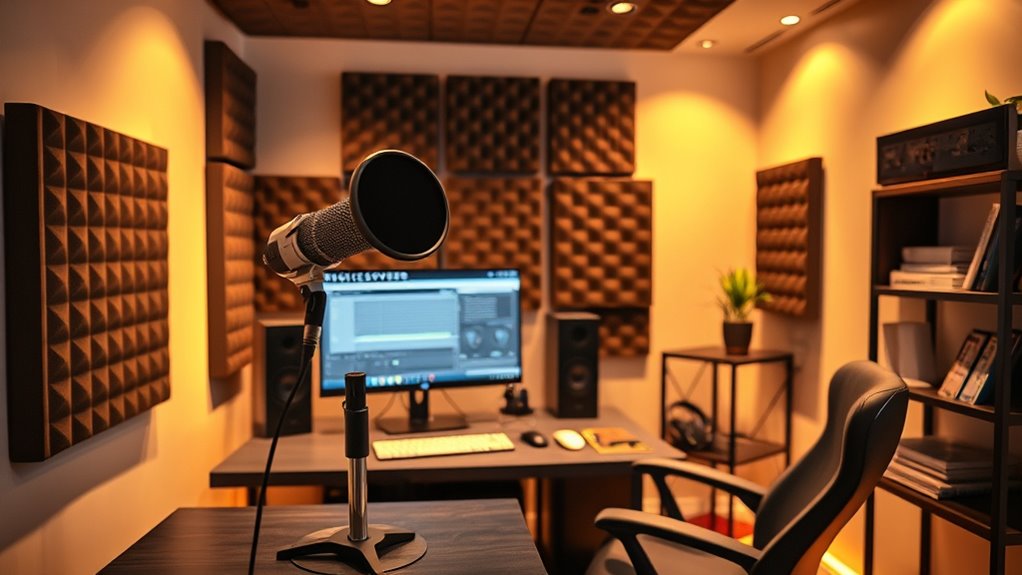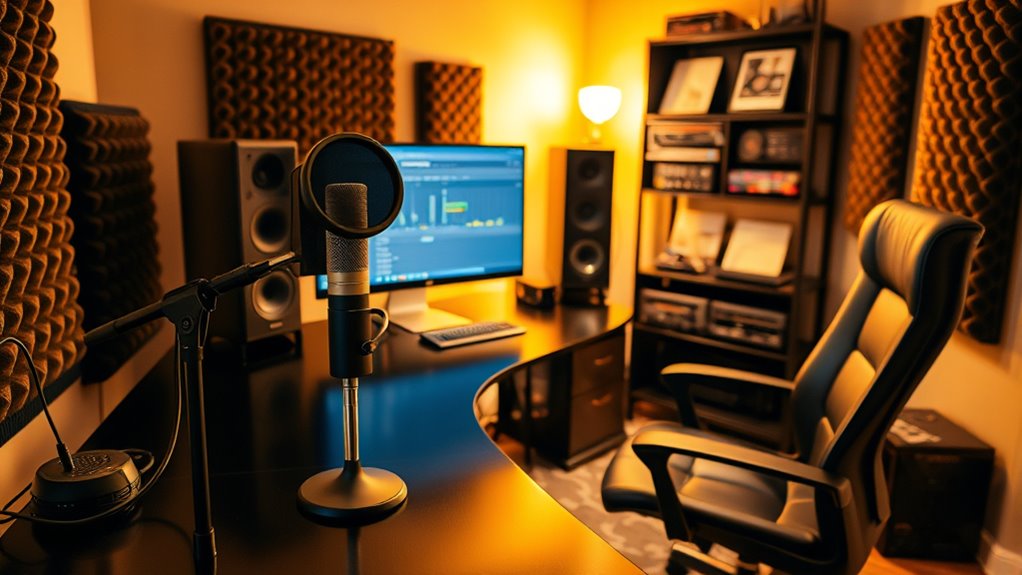To set up a home studio for voiceover acting, invest in quality soundproofing, a reliable microphone, headphones, and a dedicated quiet space. Practice recording scripts, focus on tone and emotion, and create a versatile reel. To find work, join industry communities, pitch to agencies, and submit auditions confidently. Keep refining your setup and skills, and you’ll discover more ways to succeed in your voiceover journey.
Key Takeaways
- Invest in quality microphones, headphones, and soundproofing to create a professional home recording environment.
- Practice reading scripts aloud, focusing on tone, pacing, and emotional delivery to improve audition performances.
- Build a versatile voice reel showcasing different styles and accents tailored to target audiences.
- Join online voiceover communities and industry events to network and discover new opportunities.
- Submit targeted, high-quality auditions regularly, follow up professionally, and continuously refine your setup and skills.

Breaking into voiceover acting can be both exciting and challenging, especially if you’re working from home. One of the first steps is setting up a reliable home studio that produces professional-quality audio. Your choice of audio equipment is essential. Invest in a good microphone, headphones, and a soundproof space. A condenser microphone is a popular choice because it captures a wide range of vocal nuances, but make sure it’s compatible with your budget and space. Quality headphones help you hear every detail of your recordings, ensuring clarity and accuracy. Acoustic treatment, like foam panels or blankets, minimizes background noise and echoes, making your recordings sound polished and professional. Don’t forget a sturdy desk or stand for your microphone to keep it steady during long recording sessions. Once your studio is set up, focus on mastering audition techniques that will help you stand out. Auditions are your chance to showcase your voice and versatility. Practice reading scripts aloud, paying attention to tone, pace, and emotion. Record yourself regularly and listen critically to identify areas for improvement. It’s fundamental to understand the significance of interpretation—delivering lines in a way that matches the script’s mood and purpose. Study successful voiceover artists and analyze their delivery to learn different styles and techniques. When auditioning, follow the instructions carefully—whether it’s submitting a voice reel, a specific script, or a set of directions. Make sure your background is quiet, your audio is clear, and your performance is confident. Don’t be afraid to experiment with different voices, accents, and pacing to demonstrate your range. Keep your recordings concise, engaging, and free of distracting noise. As you build your reel, remember to tailor your auditions to the project’s tone and audience, highlighting your strengths. Networking plays an indispensable role in finding work, so join voiceover communities online and attend industry events when possible. Pitch yourself confidently to casting directors and agencies, and always follow up after auditions. Consistency and persistence are key; the more auditions you land, the better you’ll understand what clients are looking for. Additionally, understanding air purification can help create a healthier environment in your home studio, reducing airborne pollutants that may affect your health and concentration. Over time, refine your setup, hone your audition skills, and expand your portfolio. With dedication, your professional home studio and polished audition techniques will help you land voiceover gigs and grow your career from the comfort of your home.
Frequently Asked Questions
How Do I Choose the Right Microphone for Voiceover Work?
To choose the right microphone for voiceover work, consider microphone types like condenser mics, which capture clear, detailed sound, ideal for vocals. Avoid cheap options and focus on quality. Also, invest in acoustic treatment to reduce echo and background noise, ensuring a professional sound. Test different microphones if possible, and select one that feels comfortable and suits your voice, enhancing your recordings’ clarity and warmth.
What Software Is Best for Editing Voice Recordings?
Imagine your perfect recording session—smooth and professional. For editing voice recordings, Adobe Audition and Audacity stand out as top choices, offering user-friendly interfaces and powerful features. To enhance sound quality, incorporate soundproofing techniques like foam panels and diffusers. These tools help minimize background noise, ensuring your audio is crystal clear. With the right audio editing software and soundproofing, you’ll craft polished recordings that impress clients and elevate your voiceover career.
How Can I Improve My Voice Acting Skills at Home?
You can improve your voice acting skills at home by practicing voice acting exercises daily, focusing on breath control, diction, and pitch. Work on character development by imagining different personalities and emotions, then experiment with your voice to bring them to life. Record yourself often, listen critically, and seek feedback from others. Consistent practice helps you refine your skills, expand your range, and develop a more versatile and convincing vocal performance.
What Legal Considerations Exist for Home Studio Recordings?
You need to navigate copyright laws carefully to avoid legal trouble. Always get written contractual agreements before recording copyrighted material, ensuring you have permission. If you use music or scripts, verify licensing rights or opt for royalty-free options. Ignoring these legal considerations can lead to costly disputes or lawsuits. Stay vigilant, read every contract thoroughly, and protect yourself by respecting intellectual property rights—your career depends on it.
How Do I Price My Voiceover Services Competitively?
To price your voiceover services competitively, start with market research to understand industry rates and client budgets. Use pricing strategies like tiered rates for different projects and discounts for repeat clients. Consider your experience, studio quality, and turnaround time when setting prices. Regularly review your rates against competitors to stay competitive. Clear communication about your pricing helps manage expectations and builds trust with clients.
Conclusion
Setting up a home studio and finding work in voiceover acting is entirely achievable with the right tools and determination. Did you know that the industry has grown by over 30% in the past five years, thanks to remote opportunities? This means more gigs are available than ever before. Stay persistent, hone your skills, and leverage online platforms. With dedication, you can turn your home setup into a thriving career in voiceover acting.








